Amelia (Mia) McReynolds is a third-year PhD student in the Rubenstein School of Environment and Natural Resources at the University of Vermont (UVM). As an ecologist studying fish population dynamics in the Great Lakes, McReynolds didn’t imagine research abroad would be a part of her graduate studies. But when the chance arose to join a fellow UVM PhD student on a research team in Germany, McReynolds jumped at the chance.
Anna Schmidt, PhD student in Biology in the College of Arts and Sciences at UVM, initiated the project. McReynolds and Schmidt both work in the Rubenstein Ecosystem Science Laboratory and are advised by Professor Jason Stockwell, Director of the lab and the Wildlife and Fisheries Biology program in the Rubenstein School.
Stockwell connected Schmidt with colleagues at the Leibniz Institute of Freshwater Ecology and Inland Fisheries (IGB) LakeLab in Lake Stechlin, Germany. The LakeLab is a part of the AQUACOSM-plus program – a network of experimental mesocosm facilities in Europe and beyond. An aquatic mesocosm is an experimental enclosure designed to maintain the natural conditions and environmental factors of an ecosystem, while still allowing for some factors to be controlled, changed, and examined.
“When Jason connected me with the scientists at the LakeLab I was excited to pursue a research project at the facility,” said Schmidt. “Mesocosms provide unprecedented experimental spatial scales to study lake processes such as zooplankton behavior and carbon flux under realistic lake conditions.”
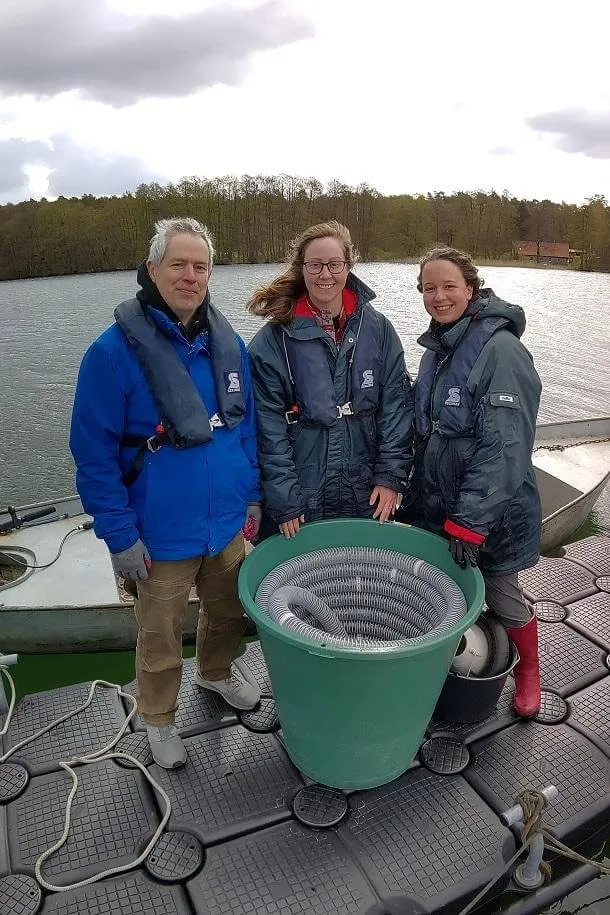
With the combined support of the AQUACOSM-plus Transnational Access (TA) program and the UVM Quantitative Evolutionary STEM Training (QuEST) (now BilDS) Program, Schmidt successfully applied to conduct a research project on her area of study, zooplankton, at the LakeLab with an international team of researchers. The project became a part of the “SPRING-FISH Experiment,” which involved more than 30 scientists from IGB, UVM, and other universities and research institutes representing 11 nationalities.
“The project needed a fish ecologist,” said McReynolds. “It didn’t directly relate to my dissertation, but it was a chance to travel, to work with a diverse group of people, and to conduct experiments with some amazing equipment.”
Working with Mesocosms in Germany
The team traveled to the LakeLab and lived onsite while conducting their research between March and June 2023. They aimed to measure how the abundance of fish influences zooplankton diel vertical migration (DVM) behavior and in turn the flow of carbon through water. DVM is the movement of zooplankton up and down in the water column over 24 hours.
DVM is one of the dominant behaviors of zooplankton in both marine and freshwater systems. Zooplankton spend the day in deeper, darker water layers where plankton-eating fishes cannot see them. At night they move to surface waters to feed on phytoplankton under the cover of darkness when fish cannot see them. After eating, when zooplankton descend for the day, they actively move consumed carbon to deeper waters much faster than when phytoplankton die and sink slowly to the bottom. This facilitates the biological carbon pump, which is well documented in marine systems. However, in lakes, the biological carbon pump has received little attention.
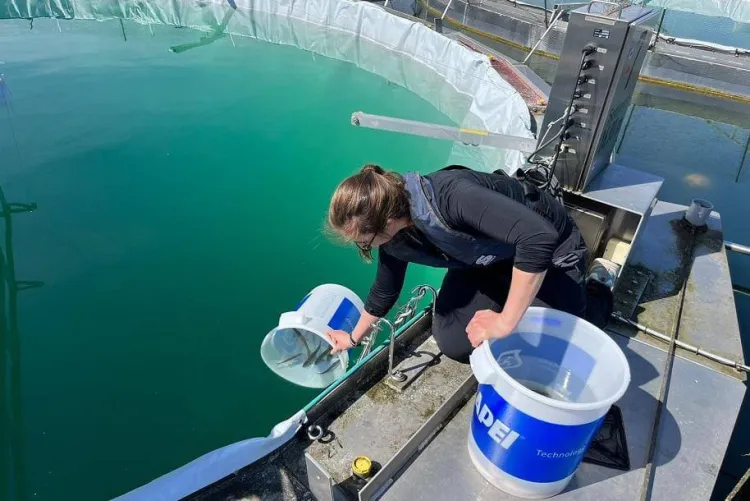
The LakeLab consists of 24 mesocosms, each 9 meters in diameter and 20 meters deep, located in Lake Stechlin in Neuglobsow, Germany. During the experiment, scientists varied the number of Roach (a small fish that eats zooplankton) across 14 mesocosms and measured how the zooplankton community and their daily migration changed in each mesocosm. They used both traditional and cutting-edge technologies to assess fish, zooplankton, and phytoplankton.
“My specialty is working with fish and hydroacoustics, which uses sonar to look at fish distributions in a water column,” explained McReynolds. “There was a learning curve when working with the mesocosms. Because the fish were in low densities in this experiment, we found custom nets worked best to count the fish. The whole experience was an excellent example of how theory doesn't always play out in the field, and you must be adaptable with your methods.”
The team captured high-definition imagery every 10 cm of the full depth of the mesocosms during the day and night to document zooplankton behavior in response to fish abundance. These measurements coincided with measurements of carbon compartments in the food web and the water, which were used to estimate how much carbon zooplankton were moving each day and whether it changed under different fish abundances.
"I have a love, hate relationship with night fieldwork,” said Schmidt. "It can be grueling. We did some 24-hour sampling campaigns where we’d go out sampling every three hours. But it’s also exhilarating and it’s a really rewarding team effort. Not to mention the beautiful starry nights, sunrises, and sunsets we were able to see from the mesocosm platform during sampling.”
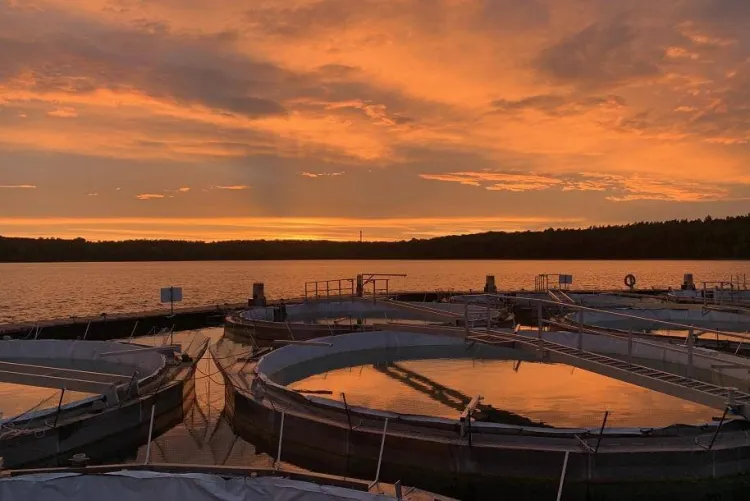
Leadership in the Field
One of the most important aspects of Schmidt’s and McReynolds’s time at the LakeLab was the leadership experience. The research team had varying levels of experience and education, and many were learning new techniques throughout the six-week experiment.
“I wasn’t entirely expecting to take on such a leadership role, I'm really glad it was a component of my experience,” said Schmidt. “I had to be on the ground all the time coordinating the students doing fieldwork. It was a lot of pressure at times, but it was helpful to develop those skills.”
“I’m happy when I’m leading,” said McReynolds. “The LakeLab hadn’t used fish as a treatment before, it was exciting to be a part of a brand-new experience at their facility and to train fellow researchers on the techniques.”
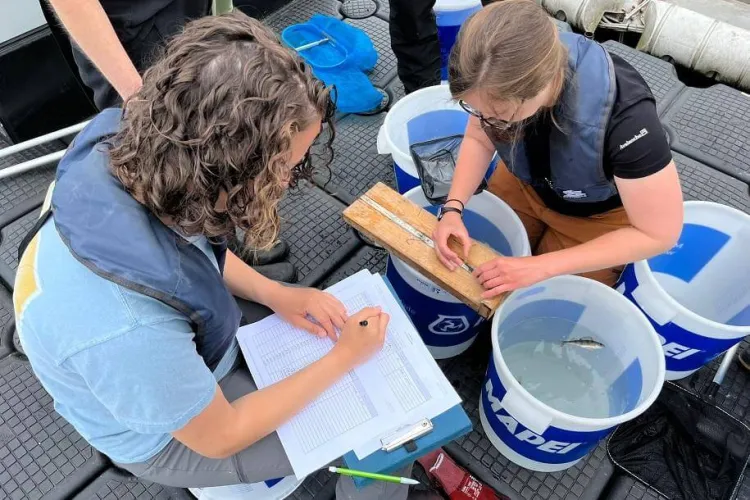
The LakeLab is in a rural setting with communal housing onsite, so the team also got to learn from one another and build connections outside of the experiment.
“This was my first experience with international research,” said McReynolds. “Living at the field station and making connections with people from all over the world was an amazing opportunity. I recommend traveling for research whenever possible, especially for undergraduates.”
Stockwell added, "When students have the opportunity to shine, they do. In this case, an international opportunity presented itself to both Anna and Mia and they excelled. The opportunity to work at an international research institute, with globally renowned ecologists, and their graduate student peers and undergraduates from around the world, is a transformative experience. I’m very excited to see how this experience and these global connections shape Anna’s and Mia’s careers."
In early June, the team celebrated the end of the SPRING-FISH experiment at the IGB summer party. They joined together for a night of dancing and celebrating, complete with a live band, delicious food, and a jump into Lake Stechlin at sunset.
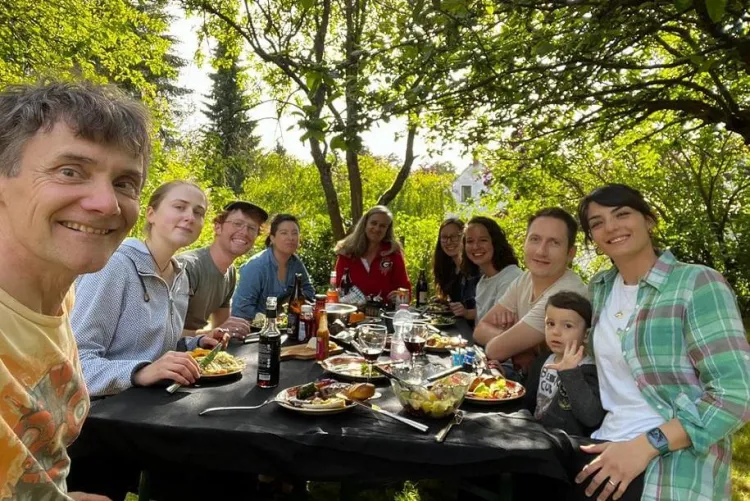
The team is now processing the many samples collected last spring and analyzing the data. Multiple members of the research team presented preliminary results at the AQUACOSM-plus Symposium held near Antalya, Türkiye, last November. Schmidt returned to the LakeLab in summer 2023 and led another mesocosm experiment, and both Schmidt and McReynolds have returned to their PhD research in Vermont with a new wealth of research and leadership experience.

